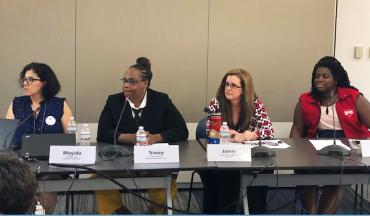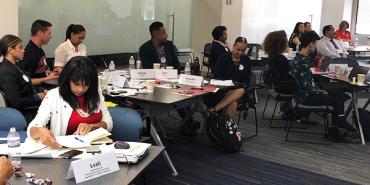At the AFT’s annual diversity summit in June, educators, policy experts and labor leaders were already well-versed in the need for more black, brown and Native American educators in our schools—and could share reams of statistics about how a more diverse educator workforce serves every student, and increases academic achievement and school completion among children of color. The AFT is moving that work forward on multiple fronts, and this year the summit looked specifically at teacher certification requirements—a recurring topic in any conversation about addressing the national teacher shortage and opening up the profession to more people of color.
The problem
The Praxis and other required licensure tests have long been a stumbling block for many who aspire to become credentialed educators. It’s been particularly problematic for African American test takers due to cultural bias in the tests, economic and geographic barriers to taking the tests, and poorly resourced schools that frequently leave these test-takers less prepared for test content and for test-taking in general. According to recent statistics from the Educational Testing Service (ETS), which creates and monitors the Praxis Core—the primary test required by many states for teacher certification—92 percent of white test-takers passed the reading portion of the test, compared with 68 percent of African American test-takers. Seventy-seven percent of white test-takers passed the writing portion, compared with 42 percent of black test-takers; and 72 percent of white test-takers passed the math portion, compared with 36 percent of black test-takers.
Hispanic test-takers passed at 80 percent, 58 percent and 56 percent on reading, writing and math respectively. Asian and Native American test-takers also fell behind white test-takers.
Breaking it down
Participants at the diversity summit did not dwell on the numbers, but instead focused on solutions. “We have seen from data the impact of what happens on the Praxis test,” said AFT President Randi Weingarten, who spoke during the two-day event. “We have to unpack that, see what that’s about and why, and determine what to do about it.”
Four representatives from ETS, the company that crafts the test, joined the summit—the idea being that they would take the feedback from education professionals and use it to find a solution to the disparity in teacher certification requirements. Led by Travis Rodgers, ETS strategic adviser for diversity and equity, they described an existing review process designed to eliminate bias in test questions, and another that evaluates overall test results for disparities based on race and ethnicity. They also recognized the limitations of their testing system and took in suggestions and concerns.
Some of what summit participants told the ETS representatives:
Cultural bias
Some questions exclude people who have not been exposed to a majority-white experience. For example, a reference to “sand traps” requires working knowledge of golf courses, which are not universally familiar, especially outside white communities.Expense
As Baltimore Teachers Union member Tracey Fowlkes pointed out, $90 per test is expensive for people who make just $22,000 a year, especially if they have to take the test multiple times before they pass it.- Test anxiety and lack of accommodation
One participant said taking the Praxis reminded one test-taker of visiting someone in prison: It was in a cold, institutional setting far from home and involved security checks. Also, it is unusual to get accommodations such as extra time for test-taking, a key point for non-native English speakers.
- Lack of relevance
Is there a direct correlation between high test scores and good teachers? The answer to this question, which ETS calls “predictive validity,” is often, “no.” Many people, especially paraprofessionals who have years of successful experience in the classroom and sometimes advanced degrees as well, are already great educators, but can’t manage to pass portions of the test. Mayida Zaal, a faculty member in teacher preparation at Montclair State University, has one student who is “a phenomenal teacher” getting stellar feedback, but she has been demoralized because she’s been unable to pass the Praxis; she will be stuck in a substitute teaching position, and students will be the ultimate losers. “We have all these people who have demonstrated that they want to become teachers, who are actually managing the class, but they cannot pass the Praxis,” said Fowlkes. “There’s no empirical evidence that just because you can’t pass the Praxis you can’t teach.”
- State-by-state regulations
The Praxis is handled differently in each state, and although ETS urges states to appoint diverse review boards for test results, that doesn’t always happen.
- Poor preparation
Through no fault of their own, many aspiring teachers have attended poorly resourced high schools, where they were not well prepared for teacher education programs or test-taking. “That reality of receiving a really inadequate education meant that I had to work 10 to 15 times harder than everyone else,” said Zaal, whose own experience reflects this issue. “Then I’d come across a test question that would make me shrivel.” And, just as wealthier families have access to expensive SAT prep programs and practice tests, the wealth gap appears in testing for teacher certification as well: Preparation programs cost money, and white test-takers tend to have more access to wealth than test-takers of color.
Finding solutions
The AFT invited ETS to the summit to confront these issues directly with the people most involved in creating and monitoring test questions and process. It’s not the first time the AFT has worked with ETS— urging the organization to consider more inclusive policies that broaden the educator workforce, and teasing out relevant issues that block people from the profession.
For one thing, the test is expensive, especially if you have to take it multiple times. ETS has a small fund available to help, but it ranges from just under $1,000 to “the low thousands” depending on the year, said ETS’ Rogers, who noted that ETS is a nonprofit with fluctuating finances. He added that ETS has begun to create free and reduced-fee interactive prep tests.
Teacher feedback has also been instrumental in shifting the weight of the algebra portion from 50 percent to 32 percent of the final test score, and in getting ETS to provide mathematical formulas so that test-takers do not have to commit them to memory.
And some states now allow accommodations for people who need additional time to take the test. Summit participants favored such accommodations, and talked a lot about removing test questions that are irrelevant to good teaching. Other ideas from the group included an option for a Spanish-language test as well as calling on teachers of color to play a larger role in crafting questions. Summit participants also urged ETS to influence states, which choose their own testing review boards, to make sure those boards include people of color.
Participants recognized that testing is not the only barrier to increasing the teacher workforce. Potential education students often choose other career paths because teacher pay is notoriously low; and respect for educators is often missing. “We need to make teaching an attractive career for people of color who are currently choosing to pursue other high-status professions,” said Peggy Brookins, president and CEO of the National Board for Professional Teaching Standards. She suggested loan forgiveness and scholarships to draw high-achieving students into teaching. “Even if this requires additional investment, we must do this now. It is urgent. We cannot wait.”
Many members are doing their own work to build the teacher workforce, especially through “grow-your-own” programs, cultivating a new generation of teachers. The Chicago Teachers Union has bargained successfully for funds for a grow-your-own program in their public schools, said CTU chief of staff Jennifer Johnson. The Baltimore Teachers Union supports a teacher academy cluster that involves education courses beginning in 10th grade, as well as opportunities to intern at local elementary and middle schools. And the Brashear High School Teaching Academy Magnet program, run by Pittsburgh Federation of Teachers member Hannah McCarthy, recently won an agreement for guaranteed placement of its graduates in Pittsburgh public schools.
[Virginia Myers]


